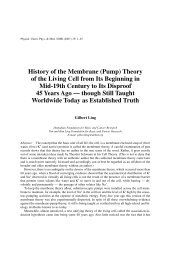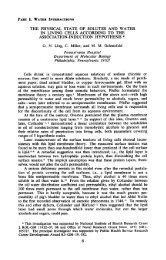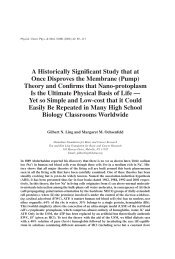Primary Thermosensory Events in Cells - Springer
Primary Thermosensory Events in Cells - Springer
Primary Thermosensory Events in Cells - Springer
You also want an ePaper? Increase the reach of your titles
YUMPU automatically turns print PDFs into web optimized ePapers that Google loves.
25 <strong>Primary</strong> <strong>Thermosensory</strong> <strong>Events</strong> <strong>in</strong> <strong>Cells</strong> 457<br />
of a transcriptional regulator prote<strong>in</strong> OxyR [42]. Activation of OxyR is achieved<br />
through the formation of a disulphide bound with<strong>in</strong> the prote<strong>in</strong>, upon which OxyR<br />
<strong>in</strong>duces the expression of a set of genes adapt<strong>in</strong>g the bacterial cell to oxidative stress.<br />
This illustrates how it is possible both to “sense” and respond to an abrupt change<br />
<strong>in</strong> a specific environmental factor <strong>in</strong> a simple, yet elegant mode.<br />
One would expect the organisms and cells to be similarly elegant when sens<strong>in</strong>g<br />
temperature shifts. Indeed, a strik<strong>in</strong>g example is the temperature-controlled<br />
switch<strong>in</strong>g of the flagellar rotary motor of E. coli between the two rotational states,<br />
clockwise (CW) and counterclockwise (CCW) [43]. The molecular mechanism for<br />
switch<strong>in</strong>g rema<strong>in</strong>s unknown, but seems to be connected to the response regulator<br />
prote<strong>in</strong> CheY-P. Two models of CheY-P action proposed so far expla<strong>in</strong> shift<strong>in</strong>g the<br />
difference <strong>in</strong> free energy between CW and CCW states <strong>in</strong> terms of (1) conformationrelated<br />
differential b<strong>in</strong>d<strong>in</strong>g [44, 45] and (2) thermodynamic changes <strong>in</strong> dissociation<br />
constants [46].<br />
Further studies on the thermosensory transduc<strong>in</strong>g system <strong>in</strong> E. coli revealed that<br />
two major chemoreceptors, Tar and Tsr, which detect aspartate and ser<strong>in</strong>e, respectively,<br />
also function as thermoreceptors, together with Trg and Tap receptors [47].<br />
Interest<strong>in</strong>gly, <strong>in</strong> spite of different specificity and sensitivity, am<strong>in</strong>o acid sequences<br />
of all these four chemoreceptors have a significant homology. They are transmembrane<br />
prote<strong>in</strong>s hav<strong>in</strong>g two functional doma<strong>in</strong>s act<strong>in</strong>g as chemoreceptors: one is a<br />
ligand-b<strong>in</strong>d<strong>in</strong>g doma<strong>in</strong> located <strong>in</strong> the periplasm and the other is a signal<strong>in</strong>g doma<strong>in</strong><br />
located <strong>in</strong> the cytoplasm. Thus, it is suggested that a temperature change <strong>in</strong>duces a<br />
conformational change <strong>in</strong> these two receptors and that this conformational change<br />
triggers the signal<strong>in</strong>g for thermoresponse. In the simplest model of thermoreception<br />
by these receptors, two conformational states of these receptors are assumed:<br />
a low-temperature state and a high-temperature state [48]. The swimm<strong>in</strong>g pattern<br />
of the Trg- and Tap-conta<strong>in</strong><strong>in</strong>g cells is determ<strong>in</strong>ed simply by the temperature of the<br />
medium, <strong>in</strong>dicat<strong>in</strong>g that these cells under nonadaptive conditions sense the absolute<br />
temperature as the thermal stimulus, and not the relative change <strong>in</strong> temperature.<br />
The understand<strong>in</strong>g of prote<strong>in</strong> thermotropic sensory transductions <strong>in</strong> terms of<br />
their underly<strong>in</strong>g molecular mechanism is fast-advanc<strong>in</strong>g thanks to the discovery and<br />
functional characterization of the transient receptor potential (TRP) channels. This<br />
prote<strong>in</strong> family, first identified <strong>in</strong> Drosophila, is at the forefront of the sensory stem,<br />
respond<strong>in</strong>g to both physical and chemical stimuli and, thus hav<strong>in</strong>g diverse functions<br />
[49, 50].<br />
The family of TRP channels currently comprises around 30 members grouped<br />
<strong>in</strong>to seven related subfamilies: TRPC, TRPV, TRPA, TRPP, TRPM, TRPN and<br />
TRPML. In higher organisms, TRPV channels are important polymodal <strong>in</strong>tegrators<br />
of noxious stimuli, mediat<strong>in</strong>g among all, thermosensation and nociception (pa<strong>in</strong><br />
sensation) [51].<br />
To characterize thermal sensitivity of cells, molecules and processes, the Q 10<br />
(temperature coefficient) is used. Q 10 reflects the rate of change of a biological<br />
or chemical system as a consequence of <strong>in</strong>creas<strong>in</strong>g the temperature by 10 ◦ C. This<br />
coefficient is used, for example, for the characterization of the nerve conduction<br />
velocity.







